New Vrindaban’s Transcendental Throwback Thursday – 05/22/14
New Vrindaban’s Transcendental Throwback Thursday – 05/22/14.
Each week we highlight an earlier era of ISKCON New Vrindaban.
This week’s challenge: Can you identify all six devotees in this photo?
What to do: Post your guesses on the “who, what, when, where & why” in the comment section at the New Vrindaban Facebook Page.
Technical stuff: We share a photo Thursday and confirm known details Sunday. Let’s keep it light and have a bit of fun!
Special request: If you have a photo showing New Vrindaban devotees in action, share it with us and we’ll use it in a future posting.
New Vrindaban’s Pujari Department Fosters Family Mood
by Madhava Smullen
It’s 7:30 on a February morning at New Vrindaban. The sun rises into an orange sky, setting the leafless silhouettes of the trees ablaze and giving the snow packed on the rooftops a golden hue. Devotees crunch over the snow to the temple for Deity Greeting, wrapped up warmly with shoulders hunched against the crisp cold.
Head pujari Abhinanda Das is dressing Sri Sri Radha-Vrindabanchandra this morning. He’s already been up for four-and-a-half hours – since 3:00am. Deity worship services will continue until 8:30pm, and he’s not likely to go to sleep until 10:30 at night.
“I have to find time to chant my rounds, too,” he says, grinning.
Abhinanda is part of an international group of new pujaris working hard alongside an existing team of senior devotee priests to maintain and increase the high standard of worship. For him, being a pujari at New Vrindaban is an adventure — a challenge, but blissful as well.
He began the adventure when he moved from his native Mauritius, where he served for many years as temple commander and pujari, in May 2012. “I had heard a lot about New Vrindaban, and wanted to have a new experience,” he says.
Abhinanda was followed later in 2012 and 2013 by Gopalila Dasi from Russia, Lalita Kunda Dasi from Mexico, Kumari Dasi from Peru, and fellow Mauritian Mangala Charan Dasi. They join many long-time residents of New Vrindaban to create a team of about twenty pujaris.
Having that many priests might seem like a luxury, but at New Vrindaban it’s more of a necessity – no fewer than 24 Deities reside on its intricate golden altars.
Back in the 1970s, when the community consisted of multiple villages called Bahulaban, Madhuban, Guruban, and the original Vrindaban farmhouse, each worshipped their own sets of Deities — which explains why there are so many today.
At the center of the temple room are Radha-Vrindabanchandra. The first officially installed Deities in New Vrindaban, They appeared at the original New Vrindaban farmhouse on Janmastami 1971 and moved to the current temple when it opened in 1983.
The other large Deities are Gaura-Nitai, Gopalnathji, Prahlad-Nrsimha – the largest Nrsimhadeva Deity in North America – Srila Prabhupada, and Jagannath, Baladeva and Subhadra, Who were carved by Nara Narayana Das in the early 1970s from a New Vrindaban tree.
Along with them are Radha-Vrindabannath, Radha-Madhava, and Laksmi Nrsimha, Shalagram and Dwarka Shilas, and smaller forms of Radha-Vrindabanchandra, Gaura Nitai and Prabhupada.
To care for all these Deities at a level befitting the Lord is a superhuman feat, making a New Vrindaban pujari’s day long and absolutely jam-packed.
After rising and showering by 3:30am they wake the Deities, offer Them a variety of milk sweets and then offer Mangala-arati at 5:00am. They then prepare jewellery, dress all the Deities, and offer Sringar-arati at 7:30am.
“At 8:00am we offer a breakfast of three different varieties of fruits, along with malpura, paratha, samosa, and orange juice or, in the winter, home-made herbal tea,” says Abhinanda.
There’s another arati at 8:30, then the Raj Bhoga arati at 12:30pm and an offering consisting of 12 to 14 different preparations, after which pujaris put the Deities to rest at 1:00pm.
At 3:30, they wake Their Lordships up again, and there are more elaborate food offerings and aratis at 4:00pm, 4:30, and 6:15. After Sandhya arati at 7:00pm, the Deities are dressed in Their evening outfits, and a final arati is offered at 8:30, before the Deities take rest for the night.
In between all of this, pujaris must make garlands, cook the various offerings, and chant their sixteen rounds of japa. Abhinanda has the added responsibility of organizing the pujari schedule and finding replacements for pujaris who are ill or have emergencies.
At the end of the day, most pujaris fall exhausted into bed at 10 or 10:30 at night, and sleep for about five hours before getting up and doing it all over again.
In the winter, when many devotees leave for warmer climates and the pujari department is halved in size, there is even more work for everyone: each pujari must dress two sets of Deities. And with the deep snow making travel difficult for those who commute, and temperatures falling to minus ten degrees, things are tough – especially for Abhinanda, who hails from a tropical island.
But here’s the unique thing about Deity worship. Despite all these challenges, Abhinanda loves his service. And surprisingly, he especially loves it during the winter.
“It’s hectic, but very blissful, because we get so many opportunities to serve the Lord,” he says. “In summer, when there are lots of devotees, you don’t always get the chance to dress all the Deities. But in winter, you get the chance to serve Them all. So you develop a relationship with the Lord, and feel closer to Him. And the more you serve the Lord, the happier you become.”
Winter brings other benefits. “Because we are just a small team, we become very close to each other,” says Abhinanda. “With so much snow outside, we tend not to go anywhere, and so our focus is just on our chanting, and on our service. We become very close to each other, and a family mood is created. That’s what I really relish – that family mood amongst the devotees.”
Of course, Deity worship is sweet all year around too, particularly during New Vrindaban’s many festivals. Abhinanda remembers being in an especially blissful mood during Govardhana Puja, when the lecture by Varshana Swami, kirtan and abhishek were especially ecstatic; and during Gaura Purnima, when he and his team spent the previous day creating flower outfits until two o’clock in the morning, and then began dressing the Deities at 5:30am.
“I got to dress Lord Chaitanya myself,” he says. “It was really something to remember – a wonderful spiritual experience.”
The Swan Festival, during which the Deities ride a Swan boat every Saturday throughout the summer, is another highlight. So, too, is the Pushpa Abhishek festival, introduced in 2011 and held every July, during which pujaris shower the Deities with 25 baskets of flower petals.
“Then we go up into the temple room dome, and pour the petals that have bathed the Deities down onto the devotees,” Abhinanda says. “And they pick up whatever petals fall on the floor and start throwing them at each other!”
Abhinanda also appreciates his pujari work because it pervades all areas of his life and helps him to develop brahminical qualities.
“Because you have to maintain a fixed schedule, it helps you become very regulated and focused,” he says. “And because you’re always touching the Lord and have to be very clean, it helps you keep your room, clothes and body clean. It helps you become clean internally too, because you’re constantly thinking about the Lord.”
Abhinanda has also become attached to the place where he serves the Lord. “For me, New Vrindaban is very special, because it was such an important project for Srila Prabhupada, and because some of the Deities were installed when he was physically present,” he says. “And of course it’s wonderful to be serving in a community where you can have the association of so many senior Prabhupada disciples.”
Moving on into the future, Abhinanda hopes to improve the standard of worship, punctuality, and cleanliness at the New Vrindaban Pujari Department. He personally guides the pujaris in this, encouraging them to repeatedly study and apply the New Vrindaban Deity Worship Manual, which was approved by the Mayapur Academy of Deity Worship. He also encourages pujaris to approach him at any time if they’re having any difficulties.
“My vision is to reach high standards like that of Mayapur,” he says. “It’s not going to happen today or tomorrow. But New Vrindaban has great potential.”
But the most important element in reaching this standard, Abhinanda feels, is creating a stable department that leaves behind the ups and downs of the past and runs peacefully and smoothly.
“I want to create a good team, and a good mood amongst the pujaris,” he says. “I feel strongly that this family mood of caring, cooperation and being supportive of one other is very important, and is the real mood of Vaishnavas.”
From the New Vrindaban Garden: Companion Plants 5-19-14
This week in the garden the weather has shown us just how unpredictable May weather can be, in a few days we went from over 80 degrees to a light frost. Many of our more sensitive plants were covered the last two nights. If you are unable to cover your plants at night often they can be saved by heavily watering the foliage before the sun has a chance to melt the frost off of the plants. This is what we did in both the Teaching Garden and the Garden of Seven Gates.
In the Garden of Seven Gates we have been working on a large bed of 300 tomatoes and 200 peppers. Within this bed we are doing companion planting. Companion planting is defined as the close planting of different plants that enhance each other’s growth or protect each other from pests. A great historical example of companion planting is “the three sisters”. According to Iroquois legend, corn, beans, and squash are three inseparable sisters who only grow and thrive together. This tradition of interplanting corn, beans and squash in the same mounds, widespread among Native American farming societies, is a sophisticated, sustainable system that provided long-term soil fertility and a healthy diet to generations.
With our tomatoes and peppers we are also planting basil, rosemary, and marigolds. This will help to deter pests and provide beautiful flowers for the temple. In the teaching garden you will find beds that have flowers intermixed with lettuce and spinach. The following link is a great site for finding basic companion plants http://www.ghorganics.com/page2.html . I hope everyone has a wonderful sunny week in the garden.
Srila Prabhupada Advocates A “Common Sense” Approach When Using Modern Conveniences To Develop New Vrindaban – December 1968
Srila Prabhupada Advocates A “Common Sense” Approach When Using Modern Conveniences To Develop New Vrindaban – December 1968.
From a series of letters written by Srila Prabhupada outlining his vision for New Vrindaban.
Thanks to Vanipedia for the source material.
——————————————————————
My Dear Kirtanananda,
Please accept my blessings. I have received today your letter dated 4, December 1968 and have carefully read the contents.
You have asked whether you may use charcoals to use for fuel during the winter and since this is the simplest thing to use in your present situation certainly it is all right. In all such questions as this you need only use your good common sense and depend upon Krishna as always to guide you nicely. So far as the government making repairs on the roads, If they are willing to do it this is very good. With nice roads we can invite many people to New Vrindaban as well as facilitate our own activities there so such proposal is welcome. For construction of ponds I don’t know if you will be able to use them for bathing in the cold winter so it is better if you can construct a well if this can be more used in the winter. So if you are pressed now for time, the ponds may be constructed in the spring.
I have noted from your letter that you have available a Lincoln automobile which you are able to donate to us in Los Angeles. At the present we are requiring just such a car so I think you may make arrangements to have it brought here. This is all Krishna’s Grace so as you are able please make arrangements for this. So far as your utilizing machinery at New Vrindaban, if such machinery is helpful than you may take advantage of them. We are not enemies of machines. If they can be used for Krishna’s service then we welcome them.
You will be glad to know that we have now signed lease for a new temple for the Los Angeles center. It is very large, fine chapel and now there is program being organized here to set everything up very nicely and invite many new people to participate in our programs. Krishna has been very kind to grant us such facilities and now there are many efforts to be made to use it nicely.
Please convey my blessings to Hrsikesa and I hope this letter finds you in good health.
Your ever well-wisher,
A.C. Bhaktivedanta Swami
Prabhupada’s Palace Nectar: On the Road
Prabhupada’s Palace Nectar: On the Road
Written by Puru das and taken from the April 1983 Issue of the Brijabasi Spirit
Pictures shows Devananda on the left and Jalakolahali on the right.
During the “off” season the Palace staff keeps engaged. Actually there is no such thing as an “off” season in Krsna Consciousness. But this refers to that time during the winter when the amount of tourists visiting Prabhupada’s Palace slows to the point that we can work on Palace maintenance and repair, and busy ourselves for the rush of visitors that will arrive in the Spring.
During the winter, three teams, consisting of Mahabuddhi, Devananda, Jalakolahali, Raghunath, Sankirtan, Jambavati devi and myself, travel all around the G.S.A. representing Prabhupada’s Palace of Gold at 30 or more Travel, Camping, Bus Marketplace and Bus Association Trade Shows. Travel is a tremendously large business in America, and literally hundreds of thousands of summer travelers attend these shows, searching for attractions and places of interest to visit.
At the shows, we set up an 8′ x 10′ booth, with a long table at the front for displaying photographs and Palace brochures. Along with our large 6′ x 8′ photo of the Palace, we also set out two other displays, three easels each, with large 16″ x 20″ color photographs of the Palace and its interior.
Just as during the earlier days of ISKCON when devotees would attend boutique shows and gift shows to market Spiritual Sky incense, we are now attending similar events to generate interest for Prabhupada’s Palace. People are very attracted by the beauty of the Palace, even in photographs, and it is quite wonderful to see their reaction.
Tourist: George, look at that! That’s just beautiful. Why, we didn’t know such a place existed in the U.S.
George: Wheeling, West Virginia, eh? Why, we go through there once a year. How come we never knew that this was there?
Devotee: Well, sir, we’ve only been open for two years to the public. That’s why we’re here at the show. To let you know about the Palace and how you can visit it. We have two large billboards on 1-70.
Wife: Well, we certainly must come and see that when we travel west this summer. We visit our daughter in Ohio once a year. We have to stop and see this!
Devotee: Please come, ma’am. It will be our pleasure to have you visit.
Couple: Well, thank you very much young man. We’re certainly glad we found out about this.
Very often, more times than we can count, the same conversation takes place during the course of a day at one of these shows. The Harrisburg Travel Show, The Columbus Travel Show, The Detroit Show, and Indianapolis Show (all of which we have attended this year) were each nine days long. During that time 300,000 to 500,000 people visited each show, and those who passed by the Palace of Gold booth were given the opportunity to start their spiritual life and make advancement in Krsna Consciousness. They may have attended the show to look at recreational vehicles, or find that perfect vacation, but when they pass our booth they are stunned by the beauty of the Palace and usually stop to take a brochure. Those that do are pretty definite about coming to visit during the next summer season.
Wife: Why Harold, we have to visit this place. Why haven’t you taken me here?
Devotee: Have him take you to our restaurant ma’am. You can dine in a very elegant atmosphere and very inexpensively at that.
Wife: Will you look at these pictures, Harold (as she pages through our photo album)? How beautiful. When was this built?
Devotee: We started construction in 1973, and it was finished in 1979. We opened to the public about two years ago.
Wife: Well, is it a restaurant, a hotel, or what?
Devotee: No ma’am, the restaurant is in the back behind the Palace. The Palace is a memorial to our spiritual leader, Srila Prabhupada. It now serves as a museum that you can see on our guided tour.
Wife: How interesting. Who built it, anyway?
Devotee: It was built by the members of our religious community. All the work was donated, and all the laborers were previously unskilled.
Wife: I see. Prabhupada, who was he, anyway?
Devotee: He is the founder-acarya of the International Society for Krishna Consciousness, the Hare Krsna movement. He was the world’s most renowned Vedic scholar, and translated the most authoritative collection of ancient Sanskrit texts from India, called the Vedic literatures. His books are found in almost every major university in the world today.
Wife: This is really fascinating. Look at those flowers. We must come this summer when your gardens are in bloom.
Devotee: Please do. You can easily get overnight accommodations, and here is some information for you about the area.
Wife: Thank you very much. We’ll be seeing you.
Many people cannot quite believe that the Palace really exists. They ask, “Is that really real?” “Is that building really in West Virginia?” “Is it made of real gold?” Then it becomes easy to explain to them that the Palace is located in ‘Almost Heaven’ West Virginia. Since many of them are likely to travel through the state, they all become candidates for visiting the Palace.
Staying away from the Holy Dhama, New Vrindaban, and living away from the association of our God brothers is an austerity worth accepting for the sake of preaching to the conditioned souls. We feel very fortunate to be allowed to travel around the U.S. and represent the Palace and do what we can to attract everyone in America to come and visit. Of course, there are many other booths at the shows, but the people who run the booths are now old acquaintances. They have all heard a little philosophy from the different devotees, and are happy to see us when we set up our booth next to theirs. A familiar face in unfamiliar surroundings is always a pleasant experience. Now, for some of the different people that work these shows, those familiar faces are devotees.
Last winter we distributed 50,000 brochures and spoke to at least twice as many people at the various shows. We expect to see many of them at the Palace this season. Last year we had over 300 motorcoach tours visit; this year the number should double. When we attend the Bus Association shows, and the Bus Company Marketplace, the likelihood of attracting whole busloads of visitors increases. At these shows, group leaders are always invited to attend the first part of the show, even before the general public is allowed entrance. All of these people are presidents of travel clubs, old-age groups, school groups, and travel agents that charter buses with the various companies. They are all very eager to find new and interesting places to take their groups.
The Palace of Gold is such an attractive place to visit. Once, during a show, the vice president of one large bus company in Pennsylvania was bitten by the Sankirtana bug. Although he had his own booth, he would encourage his customers to stop at our booth and to book a tour with us. “Listen,” he would tell them, “you’ve got to visit this place. Go on over and get their information.”
One time at a bus marketplace, a bus driver who had driven one group to the Palace last season remarked to several women looking at the booth, “Oh, ladies, don’t miss this place. We went there last year on our ‘mystery tour.’ Everyone just loved it. It was so beautiful.” He actually did a better job of convincing them than I could have. Wearing his official bus company driver uniform, he appeared a paragon of bus travel authority. They listened to him and all took information about the Palace.
It is certainly encouraging to see how everyone is actually attracted to the spiritual energy that the Palace generates. Even though they are so absorbed in material illusion, when they get the opportunity to engage their senses in Krsna’s service, many take advantage. They may think that they are attracted by the gold, or marble, or crystal chandeliers, but actually Krsna is in their hearts and it is their spiritual senses that are becoming enlivened. The Palace is situated on McCreary’s Ridge, but actually it is Prabhupada’s paraphernalia and is in Vaikuntha. When someone sees one of our ISKCON paintings they look at a “snapshot” of the spiritual world. The Palace is made of the same spiritual potency and has the same effect on them. They see the Palace, become attracted, and are convinced that they should visit. Their senses are enlightened by Krsna’s internal potency.
Materialists are usually not attracted to devotional life, so devotional service is the last thing from their minds. Nevertheless, by the mercy of Krsna’s devotees they become interested in some aspect of Krsna Consciousness when they visit and see the opulence of the spiritual world manifest in the hills of West Virginia. They may not become devotees in this life, but they will never lose the benefit they derive from coming in contact with a pure devotee. Krsna and Krsna’s pure devotees are all-attractive. The Palace of Gold is like a powerful magnet that draws them here for a visit. They may never engage in any other devotional service for the rest of their lives, but their spiritual bank account has begun.
All glories to Srila Prabhupada, as he is benedicting the fallen souls of Kali yuga with unlimited opportunity to engage their senses in the Lord’s service.
New Vrindaban Board Meeting Reflects Cooperative Spirit
New Vrindaban Board Meeting Reflects Cooperative Spirit.
By Madhava Smullen
From the very beginning, this spring’s Semi-Annual Joint Boards Meeting at New Vrindaban reflected the cooperative spirit that has been growing in the community since its current transformation began.
Held on Saturday March 22nd and Sunday March 23rd, 2014 at the Palace Lodge conference room, the Meeting introduced two significant changes.
The first was the addition of two new Board members, Bhima and Kevala, both second generation gurukulis. Bhima is a member of the Eco-Vrindaban board, while Kevala is a member of the ISKCON New Vrindaban board.
“As part of its transformation New Vrindaban is engaging the next generation, which historically hasn’t happened as much as it should have,” says ECOV board member Chaitanya Mangala, himself a second generation devotee. “So this was a conscious move in that direction.”
Becoming a Board member has had a positive effect on the life of Kevala, a 35-year-old software tester for JP Morgan Chase who grew up in New Vrindaban and now lives in Philadelphia.
“Growing up in New Vrindaban I didn’t participate so much in the community — I was kind of a taker,” he says. “But being part of the Board, I started to feel the community spirit, and to feel like more of a giver. Like I was participating. And I really enjoy it.”
Since he has been on the Board, Kevala says he has also received a lot of thoughts and suggestions about New Vrindaban from his peers. “I think it gives a voice to the second generation,” he says. “They feel like they’re getting heard.”
The second significant change to this spring’s Meeting was to the structure. Previously, the Boards held a dialogue presenting what they had talked about with the community at the end of the weekend.
“This time, we decided to turn that on its head and share our topics with all interested members of the community first thing on Saturday morning,” says Chaitanya Mangala. “Then we’d get their feedback, and use it throughout the Meeting as part of the decision-making process.”
Thirty to forty community members attended the session from 10:00am to 1:30pm during which Board members presented a number of projects to focus on for the next five years, and asked for feedback on which should be prioritized.
One high priority was to create a devotee care department that puts the same level of resources and energy into caring for devotee residents, as that which is currently put into congregational development.
Another was making sure there is enough manpower and funds to care for New Vrindaban’s protected cow herd, which aims to maintain the current number of eight milking cows at all times and to have a projected herd of 100 cows in the next five years.
Onsite food production is another area of New Vrindaban which will get a lot of attention this year. “We just hired Kacey Orr, a local Wheeling resident who ran her own organic farm in the area for five years,” says Chaitanya. “She’s excited about going from a small operation with few resources to heading up a five-acre garden with significant resources supporting the effort.”
New Vrindaban’s infrastructure, neglected for decades, is also a focus. The Palace Lodge, which received a major renovation of its guest rooms early last year, will now see its ground floor space converted into more guest rooms and conference rooms of different sizes. And Srila Prabhupada’s Palace, which is undergoing a complete restoration in the long term, will have its front stairs and entranceway renovated this year.
Another infrastructure problem is the lack of housing in New Vrindaban for residents. Board and community members discussed plans to buy existing housing in the area and build new apartments and houses – essential steps to have more devotees move to the community.
Additionally, the Deities’ kitchen and dressing rooms will receive upgrades, and a heating and cooling system with temperature control will be installed to make both the Deities and the devotees caring for them more comfortable.
With all these priorities discussed, Board members took a break for lunch before going on their bi-annual tour to parts of the New Vrindaban property.
This time, new gardenerKacey Orr took everyone on a tour of New Vrindaban’s gardens. First came the smaller Teaching Garden, which Sunday guests often tour as their guide leads a spiritually-minded chat about the importance of simple living and local produce.
“The Garden is getting a makeover this summer,” says Chaitanya Mangala. “Its eight-foot fence for keeping out deer is twenty years old and needs to be replaced. The beds will be reconfigured with a layout that works better for giving guest tours. And we’ll start growing fresh flowers for the Deities, as well as perennial herbs to use in cooking and developing homeopathic tinctures.”
Next the Board members followed Kacey to the hill behind the temple, where the seven acre Garden of Seven Gates lies. There Kacey laid out her plans for planting different kinds of vegetables and supplying the Deity, devotee, and restaurant kitchens with fresh produce.
Next, Board members took a tour of the temple barn, where all the eight milking cows are kept, along with their youngest calves. “We’re now at a point where we have a surplus of milk,” Chaitanya says. “So independent devotees living in their own houses can use some too.”
Finally, the tour went on to the main ECOV barn in the valley, where devotees have been steadily renovating and improving facilities. While in the late 1980s they housed 400 cows, there are now only about fifty, allowing for much more space and attention for each cow.
With more financial resources now available at New Vrindaban, veterinary care has also vastly improved, allowing devotees to put up the large amount of money needed to, for instance, set and repair a cow’s broken leg – something they wouldn’t have been able to do before.
Wrapping up the tour at 5:30pm, Board members then attended the monthly sanga with Srila Prabhupada at his Palace. After kirtan, Chaitanya Mangala – who met Srila Prabhupada several times as the child of devotee parents – and Tamohara Das, who remembers Prabhupada spending time with his own children, shared their memories of the ISKCON Founder Acharya.
“It’s a wonderful space to do that kind of thing, sitting in the small temple room, spending time with devotees and appreciating Srila Prabhupada in his Palace,” says Chaitanya.
The next morning, New Vrindaban’s fifteen department heads each took five to ten minutes presenting how they planned to continue improving their areas of responsibility in 2014.
Highlights included a presentation by head cowherds Ananda Vidya and Lalita Gopi, who milk the cows twice a day, seven days a week. Reporting that the number of milking cows had gone up from six to eight this year, they pointed out the importance of maintaining quality care and avoiding rapid expansion.
New Govinda’s restaurant manager Vasudeva Das then spoke about introducing more Western-friendly dishes to his menu, to appeal to the Western tourists Prabhupada’s Palace managers hope to attract. This year Govinda’s also plans to increase its use of protected cow dairy products and locally grown produce. And the staff will begin wearing uniforms – Govinda t-shirts with dhotis – that will add to customers’ unique exotic experience.
Vasudeva’s son and Palace Lodge manager Gaura Bhakta Das then outlined his plans for focusing on the quality of service offered to Lodge guests. These include a standard uniform with nametags so that guests know who to approach for information, and personal service such as carrying guests’ bags and showing them right to their room.
The Sunday Feast program followed the presentations. In the evening, there was a lively two-hour community dialogue in which the discussions and conclusions of the weekend were presented. Board members plan to move this dialogue, and the department heads’ presentations, to Saturday morning at the next Meeting in November, for a less repetitive feel.
Overall, however, the Meeting was productive and reflected positive progress at ISKCON New Vrindaban.
“You can see that the level of energy and enthusiasm is increasing, and there is a greater mood of cooperation amongst the devotees,” says Chaitanya Mangala. “Underlying everything is a growing level of awareness and respect for each other – for the years that everybody has dedicated to making Srila Prabhupada’s vision a reality. Seeing that evolve is the most enlivening thing for me.”
GOD’S ANGER – Reflections on the Installation of Lord Nrsimhadeva in New Vrindaban – June 1986
GOD’S ANGER
Reflections on the Installation of Lord Nrsimhadeva in New Vrindaban.
From the Brijabasi Spirit, June 1986.
by Gadadhara dasa
A million years ago, in a previous era, the universe was controlled by the terrible demon, Hiranyakasipu. His five year old son, Prahlada, was a great devotee of the Lord and was always instructing his classmates on the science of Krsna consciousness.
Hiranyakasipu couldn’t tolerate his saintly son, so he tried to kill him in so many ways, although failing again and again. Finally, Lord Krishna personally appeared as Nrsimhadeva, to protect His small devotee, Prahlada, and kill Hiranyakasipu by tearing him apart.
“I offer my obeisances to Lord Nrsimhadeva, who gives joy to Prahlada Maharaja, and whose nails are like chisels on the stone-like chest of the demon Hiranyakasipu.”
1986 began in a most auspicious way in New Vrindaban. Lord Nrsimhadeva, the half-man, half-lion incarnation of Lord Krishna, decided to appear at our annual New Year Sankirtan Festival, held the first week in January. By His causeless mercy, He appeared as a seven-foot tall, coal-black Deity, with piercing red eyes, accompanied by his five year old eternal associate, Prahlada Maharaja.
Prahlada is standing with folded hands in front of His Lord, who is seated on a magnificent golden throne. In one hand Nrsimhadeva has a conch and in another a chakra (discus). At the end of His powerful fingers are gleaming, golden fingernails. His black and gold mane, like an effulgence, frames His glowing red eyes and fierce snout,where two downward curving white fangs protrude. A jeweled helmet of gold adorns his head.
Thinking back to the first time I saw Lord Nrsimhadeva, I remember Him vividly in a painting on the wall of the Radha Krishna temple in New York, during my first visit there. It was a frightening scene to behold.
I could almost hear His thunderous roaring as He placed the demon-king Hiranyakasipu on His lap and disemboweled him. Blood was flying everywhere. Bhakta Prahlada was calmly looking on with tears of love and devotion in his eyes.
I stopped myself from gawking, pulling myself away to ask a nearby devotee what all this meant. His answer satisfied me then and still satisfies me: “This is Lord Nrsimhadeva” he said. “He is God’s anger personified, and He’s proving to the world that the Lord protects His devotees.”
Soma das, New Vrindaban’s sculptor, had previously been requested to carve a Prahlada-Nrsimha murti. Soma became inspired with the project and soon carved out of clay a beautiful form. With the help of Kumara das and the mold shop crew, a mold was made and the casting went very smoothly.
“When Lord Nrsimhadeva wants to appear, no one can stop Him,”
Sampat Kumar Bhattacharya, a priest for the famous Tirupati temple of Balaji in South India, was consulted from beginning to end on many details of the Lord, and the Silpa Sastra and other Vedic texts were carefully referenced.
Most people can’t understand that the form of the Lord is not a concoction of anyone’s imagination; authorized descriptions can be found in the revealed scriptures. At the request of the Lord’s pure devotees, Krishna agrees to personally manifest as the arca-vigraha incarnation.
A golden altar and throne were cast in the mold shop and were placed to the right of Sri Sri Radha-Vrindaban Chandra’s altar. The Sankirtan Festival was ecstatic. Three days of chanting, dancing, feasting, plays, videos, initiations and other festivities pushed us all forward into new realms of transcendental bliss.
The ceremonies inaugurating the appearance of Lord Nrsimhadeva were organized and overseen by Gaura Kesava Prabhu, who previously installed the great Nrsimhadeva Deity in Germany. The festivities began with Gaura Kesava explaining the meaning behind all the rituals, followed by a fire yajna and a bathing ceremony. After the yajna, all the devotees had an opportunity to bathe the Lord and His devotee, Prahlada.
That evening, there was one of New Vrindaban’s memorable three-hour kirtanas. The giant kirtana hall was packed with people. The lights were dimmed. Mounds of rice with candle wicks were placed on the floor, creating as aisle of ghee lamps. Young maidens carrying auspicious items were presented before the closed curtain.
Then at about 9:00 p.m., the curtains opened and Lord Nrsimhadeva, resplendent with garlands, a jeweled golden crown and golden ornaments, accompanied by Prahlada Maharaja, also fully decorated and effulgent, blessed us with His darsan.
The Lord’s beautiful red lotus eyes will bring great pleasure to the devotees and strike fear into the hearts of the demons.
“God’s personified anger…protecting His devotees…” I flashed back. Lord Nrsimha’s visage seemed peaceful and calm at this point. It seemed that Prahlada Maharaja, a five year old boy, alone was able to keep the Supreme Personality of Godhead from standing up and shaking the whole universe with His unearthly roar. I could appreciate Prahlada more than ever before, and how Krishna can be controlled only by the love of His devotee.
Now some time has passed since the New Year appearance of Lord Nrsimhadeva and Prahlada Maharaja. Our temple activities are more exciting and glorious than ever. The Gurukula boys perform all the morning arotiks to Lord Nrsimhadeva. It’s a great thrill to see young boys worshiping the most powerful personality in all of creation.
I’m looking forward to seeing the amazed look on the faces of the thousands of visitors this season when they first see the transcendental form of Lord Nrsimhadeva. I hope someone will ask me who He is. Then I will have the chance to tell them, “He is God’s anger personified.”
New Vrindaban’s Transcendental Throwback Thursday – 05/15/14
New Vrindaban’s Transcendental Throwback Thursday – 05/15/14.
Each week we highlight an earlier era of ISKCON New Vrindaban.
This week’s challenge: Can you identify all six devotees in the photo?
Extra credit: What’s the occasion & when was the photo taken?
What to do: Post your guesses on the “who, what, when, where & why” in the comment section at the New Vrindaban Facebook Page.
Technical stuff: We share a photo Thursday and confirm known details Sunday. Let’s keep it light and have a bit of fun!
Special request: If you have a photo showing New Vrindaban devotees in action, share it with us and we’ll use it in a future posting.
Ananda Vidya leading New Vrindaban’s Kartik 24 Hour Kirtan – October 19th, 2013
Video of Ananda Vidya leading New Vrindaban’s Kartik 24 Hour Kirtan – October 19th, 2013.
From the New Vrindaban Gardens: 5-13-14 Tomatoes & Apothecary Garden
This week was a busy one in the garden. The first of our summer crops was planted, tomatoes. We planted three varieties this week Sungolds (exceptionally sweet, bright tangerine-orange cherry tomatoes), Rutgers (The legendary Jersey tomato, introduced in 1934 great tasting both fresh and for cooking), and Hillbillies (large bi-color heirloom with red and yellow marbling. Large with a rich, sweet flavor. An heirloom believed to be from West Virginia). The tomatoes were planted on red tomato mulch. This red plastic is used for both tomatoes and peppers it allows for more light transferring and has show to increase yields up to 20%. It also decreases the number of nematodes which are harmful insects to tomato plants.
The Teaching Garden which this year is in it’s first phase of becoming a medicinal apothecary garden has been receiving a ton of TLC. Dr. Nick Tsacrios and his crew have been working on a beautiful new fence. Marty Wach has been taking the lead on the planting in the Apothecary Garden. Marty and his wife Delia write children’s book and she is an accomplished artist. Marty the Gardener has an amazing history with medicinal plants. In the early 1990’s Marty went to Suriname, South America, for business and by chance met a Maroon Medicine Man. This led to a trip into the rain forest and meetings with the chiefs of the four Maroon Indian Tribes to discuss their need to create trade and commerce with America. Marty suggested the creation of sustainable micro-businesses as a solution to creating new trade relationships. The projects included the search for new medicines, aviculture, butterfly farming, poison dart frog research and eco-tourism. Now many years later he is bringing his great ideas to New Vrindaban. This year the garden will have flowers, vegetables, and medicinal herbs. Beside the tool shed is a wonderful area that Marty hopes to hold educational gardening classes in the future. Until next week happy gardening to all……
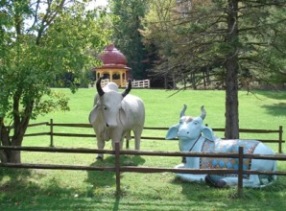
Welcome to Brijabasi Spirit
Thank you for taking the time to visit the New Vrindaban community blog. Think of visiting our blog as making a virtual pilgrimage.
Hare Krishna Hare KrishnaKrishna Krishna Hare Hare
Hare Rama Hare Rama
Rama Rama Hare Hare
"May cows stay in front of me; may cows stay behind me; may cows stay on both sides of me. May I always reside in the midst of cows."
Hari Bhakti-vilas 16.252


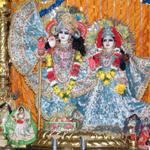
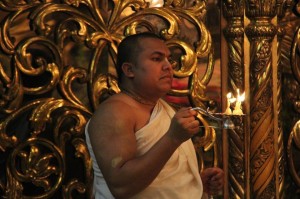
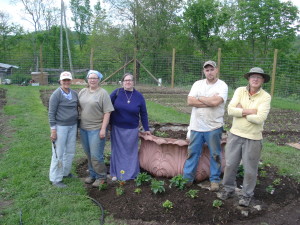








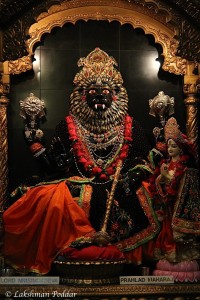
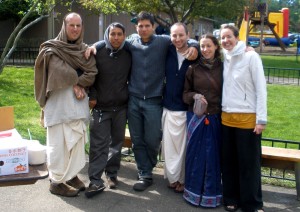






Recent Comments